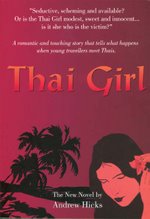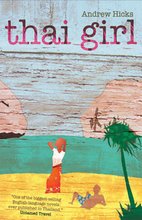
The 'Pu Ta' animist shrine by the pond in the rice fields.

Making offerings for the village's most powerful spirit.

Pu yai baan, the village head, blesses the offerings with water.

The old ladies pour offerings of rice whisky.

Not a bad way to start the day really...

... with alcohol and chicken to follow.

And if his gizzard's straight it'll be a good year.

But her future's not on rails. The world is changing.
A Ceremony Older Than Buddhism
I have just watched a remarkable village ceremony, a propitiation of the spirits at a special shrine that owes no reference whatsoever to Buddhism.
I write in my recent book, “MY THAI GIRL AND I”, about the importance of Buddhism in our village and how it coexists happily with older animist belief in the spirits of the fields and the spirits of the dead. So many of the ceremonies that I see around here, despite the Buddhist trappings, are thus in fact ‘animistic’ in origin, ancient spirit worship much older than Buddhism.
While the Christian god is a jealous god, Buddhism has no god at all and so perhaps can coexist more easily with the spirits of much older beliefs.
I talk (at page 129 of the book) about the special village shrine, the pu-ta which uniquely has no relation whatever to Buddhist styles but looks remarkably like an African shrine to animist spirits. I’ve read that at these village shrines there are two major ceremonies every year but at the time of writing my book I’d never seen them.
Now at last I have and it was truly fascinating.
The other day Cat told me there was to be a big ‘Buddha party’ down by the pond that morning and told me to bring my camera. I was feeling almost too lazy to go but thank goodness I didn’t miss it. She went ahead with some chicken she’d killed and cooked while I followed on my bike.
The shrine by the pond is a square shed of concrete blocks with a corrugated roof, totally unadorned which could be a pump house or small storage hut. The front is open and inside is a raised area on which stand two roughly carved figures, male and female, she vaguely European, he with a droopy Mexican moustache. Scattered around them are several carved wooden rifles, a few chunks of laterite stone and some plastic bowls with the dried up remains of food offerings in them.
You see these shrines on the fringes of every village overlooking the rice fields and they’re always much the same, often newly built, plain and white, in stark contrast to the bright style of Buddhist temples.
Anyway, as I arrived on my bike that day, perhaps fifty people were hanging around the shrine, mainly women and children chatting happily in the easy way they do. Inside on the floor, wall to wall, were offerings of food, mainly cooked chicken and bottles of lao khao, Thai rice whisky.
The pu yai baan, our village head soon appeared and splashed water around the figures on the altar while two old women poured offerings of alcohol into a bowl, everyone casually looking on. Then those who’d made offerings retrieved them and started breaking the heads off the chickens, while an old woman threw buckets of water up onto the roof, laughing and joking. The main focus of the morning was then to examine the gizzards of the chickens.
I’d previously seen this done just after Cat and I had first come to the village… they’d consulted the spirits to see if our future together looked positive. If the gizzard from the neck of the chicken they’d killed was reasonably straight we’d be okay but if not it wouldn’t work out. Old uncle gave the thumbs up, saying we’d be fine… at least that is if Cat didn’t talk too much!
Now beside the pond, having made their offerings and done their duty to the spirits of the pu ta, everyone seemed happy with their gizzards and they all just wandered off home, looking forward to a special meal of rice and chicken.
As usual I asked Cat for her interpretation of the ceremony and it’s to ask for good fortune in the coming year, which of course means a plentiful rice harvest. I wondered too if the throwing of water was a symbolic request for good rains which is the key to a farmer’s prosperity.
As customs such as these are universal over a wide region, and having no holy books, I’m sure that the exact beliefs vary from place to place. I also suspect that they’re not very precise… the ritual simply carries on by habit from year to year and generation to generation because that’s just what you always have to do.
I’ve read that the pu-ta is the chief shrine of the village, the spirit itself deriving from an ancient ancestor who, if duly venerated, like a father figure will care for his ‘children’. However, if a village is racked with drought and illness and other misfortunes, then the influence of the pu-ta may wane because he has neglected this duty. The pu-ta is the central reference for social order, a refuge in times of trouble and a protection against danger. While he may punish the villagers for their misdeeds, they will look for other protectors if they suffer bad times despite having honoured his shrine.
The ceremony that I saw suggests that the old beliefs or practices remain strong in our village… everyone knew this was to be the day and had killed and cooked a chicken as an offering. Rituals such as this will continue though, even when the essential beliefs are slipping. The visit to the shrine was a pleasant social occasion to look forward to and a small investment to assure future security. As Thailand becomes more and more urbanised it will however become a sad affair for the old people left behind in the villages who still remember the old ways.
I now wonder how the little girl I photographed at the scene will remember ceremonies such as this one and what they’ll mean to her as she grows up and moves away from home. Her very traditional old grandmother was one of the crones offering alcohol to the spirit of the temple, while the tiny girl was in a ‘Thomas the Tank Engine’ tee shirt.
So where will this child’s life lead her now? Her family is poor and she’ll probably leave school early to go to Bangkok to earn pitiful wages. Despite her village upbringing, life for her will be very different to that of her grandparents. As rice farmers who first had to cut back the forest to make rice fields, facing tigers and elephants and drawing up the ladders at night to keep safe from bandits, for them it’s been hard.
It won’t be easy for their grandchild either and from the sweatshops of the city she may well remember her village childhood with nostalgia and regret.
Andrew Hicks The ‘ThaiGirl’ Blog March 2009





3 comments:
Andrew , thanks for taking the time to visit the site and to take those great pictures , we too have little cermonies , not related to Buddism, but to ancient beliefs, but most of our older folks have pasted on with hopes of coming back as rich folks in BKK and not having to work in the fields and live in the bamboo huts in their next life , lots of tambon and making of merits to achive a good new life .
Most of all I loved you little side story,about the little girl and whats ahead for her in Thailand with the ever changing culture and western influence, and the economical down turn.We know that life in the small villages will never be the same, I wonder about our our village also , and I am afraid as you are that the the young folks that flee to bigger cities will only remember the hardship of living in the village and not the good times growing up with love and affection from parents and grand-ma and the elders in the villages ,LONG GONE and sadly FORGOTTEN.
Thanks again for the heart stiring post. Malcolm
It sounds as though the "pu ta" plays a similar role to the "paya nak", or Lord Naga, of the central Mekong region; a strict moral disciplinarian. There is also an echo of the "rice barn spirit house", usually placed near a "turtle pond", as seems to be the case in your photo. I read that the old turtle pond adjacent to the Emerald Buddha Temple in Vientiane used to be filled with water from the Ganges, and used as lustral water for very special occasions. Apparently, there was also a "turtle pond" near the Emerald Buddha Temple in Bangkok, but it has long since gone. So the association of pouring lustral water, ponds, and spirit houses for the spirits of the rice harvest, is all there. What a pity that the meanings of many of these traditional ceremonies seem to be lost. The local people have "always done it" and claim it to be "Buddhism". And how lucky we are to witness these ceremonies being conducted sincererly, not yet as a cultural show. Keep sharing your tales!
I got into your blog when researching for what people thinking about Thailand. When I first visit Bangkok I found that I can see Temples everywhere, especially during the tour of the Chao Phraya River. I've saw the real lifes of people living on both sides of the river, It's a heart warming experience for me. One things to remember: when visiting temples, show respect to the Buddha, and the monks. Take off your shoes before entering into the hall and don't wear shorts or tank tops in temples.
Post a Comment